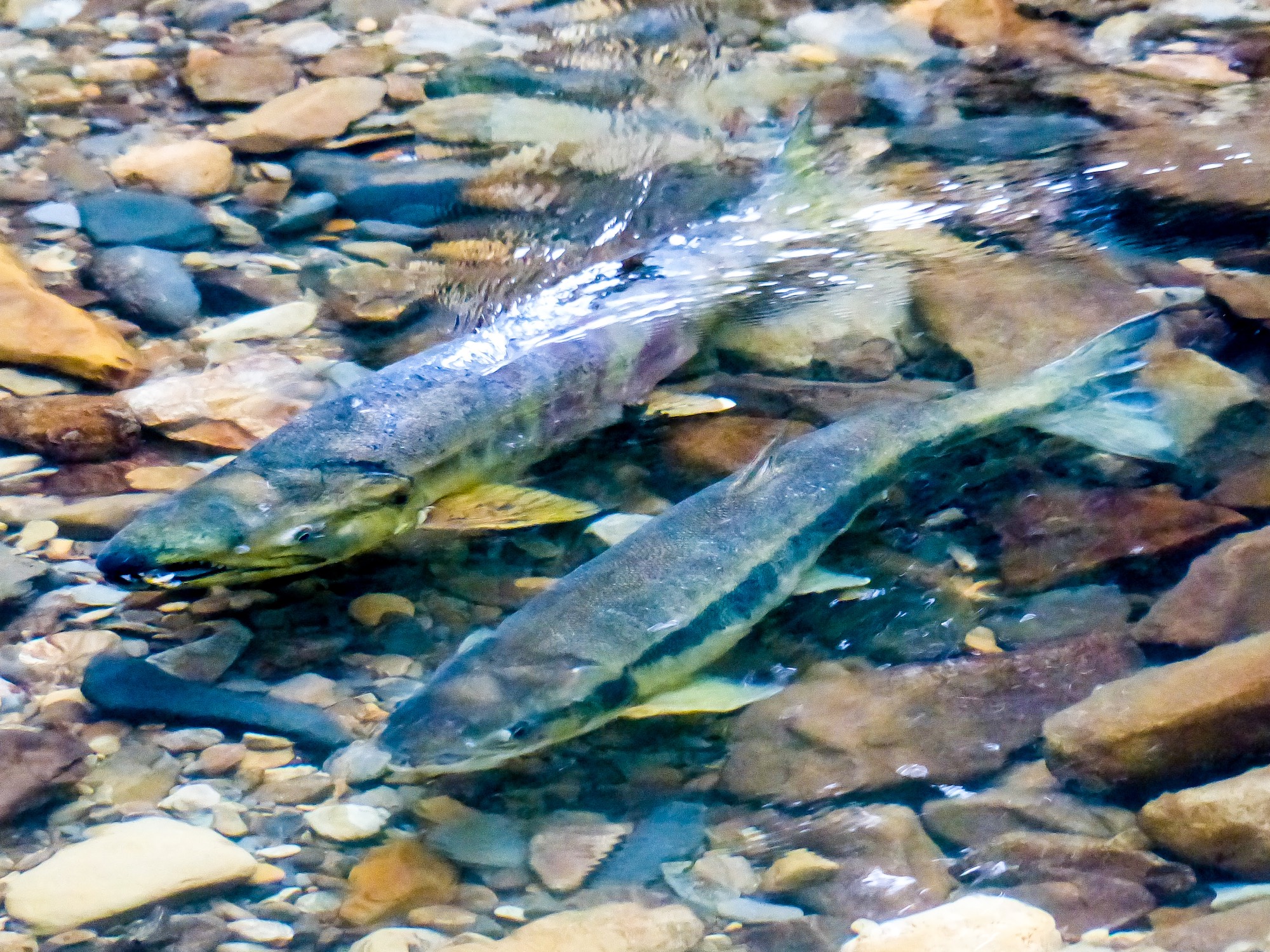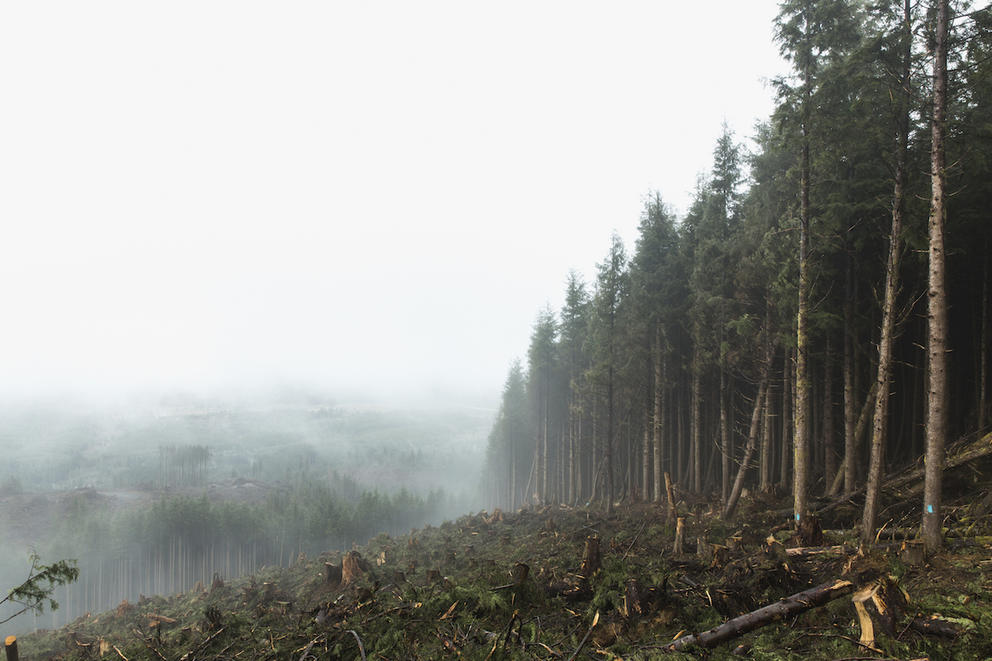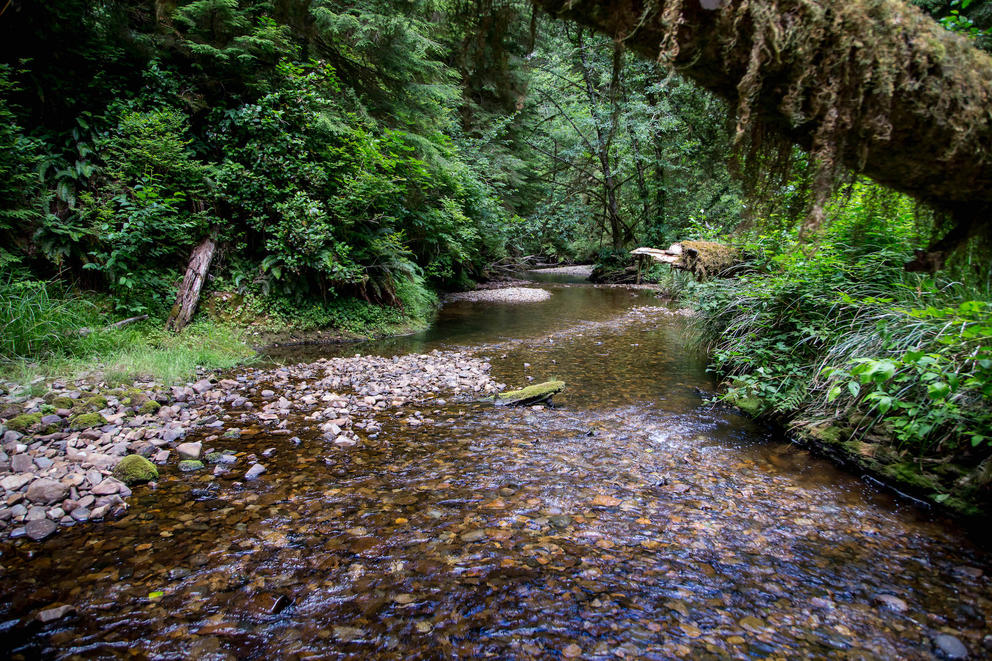Not far from these ancient trees, we ride in a big gray King cab pickup driven by TNC forester Kyle Smith on a rock-chip-crowned road along a ridge top with Verdun-like clearcuts on land owned by a for-profit corporation on one side and a dense stand of young Douglas fir owned by TNC on the other.
The Nature Conservancy owns all this land on the near side of the ridge, the whole 7600-acre Ellsworth Creek watershed near Willapa Bay. The creek flows into the Naselle River, which flows into the bay. It hosts the largest salmon run that swims through Willapa Bay. Its watershed, near Highway 101, has the greatest density of amphibian species in Washington. It’s so far south that, looking from a ridge across a neighboring clearcut, you can see the mouth of the Columbia River.
The organization is reshaping young industrially-planted stands so that they can develop into the stands of old growth — big trees more than 150 years old that provide frameworks for complex forest ecosystems — of the distant future. And TNC is trying to do it in a financially sustainable fashion while paying attention to the livelihoods of surrounding communities.
Their operations, which also involve other nearby forests, include timber cutting. But they go about it in their own way.
As Rolph explains, a forest products company would thin the young trees, too, but the goal would be even spacing with a bit more growing room. “We do it very differently,” he explains. TNC’s goal is “creating complexity.” In order to do that, contract loggers work on the spacing and “adjust the species mix. We may take out more Douglas fir and western hemlock and keep all the Sitka spruce and western red cedar that may have regenerated.”
Douglas fir has always grown in the watershed — see the scattered giants among the old growth on TNC land — but historically, on land soaked by 100 inches a year of coastal rain, cedar and spruce made up most of the forest. In 1942, Rolph says, TNC research indicates that 87 percent of the Willapa Bay watershed's old growth remained; now, the figure is less than .5 percent — half of 1 percent. In place of the old forest, companies have replanted the land with monocultures of Douglas fir and hemlock. No one who's in it for the money replaces Doug fir with red cedar and Sitka spruce. But that's exactly what Rolph and Smith are doing.
This is, among other things, a great experiment. It has to be: "We don't fully know the best pathway to get back toward old growth," Rolph says.
When they started, Rolph and the others sought advice from people who were working to restore redwoods in northern California. And they consulted the Clinton administration’s Northwest Forest Plan of 1994, created in response to the national controversy over the fate of the Northern Spotted Owl. The plan calls for preserving old growth on federal land where it still exists, but also on developing old growth in places where it doesn’t. The trouble is, Rolph explains, the plan is all based on modeling. He and his colleagues have had to figure out how to do it in the real world.
They had fewer doubts about re-shaping the watershed’s network of old logging roads. TNC has ripped out ("decommissioned") old roads and faulty culverts that spilled mud into the creek and its tributaries, building new roads up on the ridge tops with better drainage and more erosion-proof rock.
The decommissioning work "presents great challenges," says Matt Ohrberg, whose company builds logging roads for a number of corporate landowners in the area but gets rid of old roads on the land owned by TNC. In many cases, the fill material on which those roads were constructed was 40 feet deep, Ohrberg says. His crews bulldoze the fill dirt up neighboring slopes, re-creating natural grades.
How do they know when they've reached the original ground level? Natural soil looks different from fill, he explains, but to be sure they've located the original forest floor. "Old-growth stumps are what we hope to find."
TNC has also gated the roads — meth heads stole cedar before sturdy gates went up. (Smith talks about encountering guys with drugs and guns.)
The decommissioning effort is already paying off in improved water quality: "You can go there in the pouring rain," Rolph says, "and the [creek] is clear."
They're doing this as a controlled experiment, leaving some old roads in place and some dense stands unthinned, but they can see how some of it is going to turn out: In a stand of young Douglas fir packed so tightly together you can’t see daylight through them on the other, a red cedar seedling is trying to grow in the perpetual gloom of the tightly-packed firs. Rolph says the young tree won’t make it.
This all started in the late 1990s when a stand of old-growth timber at Teal Slough, near the mouth of the Naselle River, came up for sale. TNC got a grant from the Paul G. Allen Family Foundation to buy it and give it to the U.S. Fish and Wildlife Service, which incorporated it into the Willapa Bay National Wildlife Refuge. (TNC now manages the refuge woodlands along with its own. Re-shaping the landscape on that scale is "a phenomenal way to manage our forests," says refuge manager Jackie Ferrier.) Rolph explains that he and his colleagues figured a hundred acres of old growth didn't amount to much, but wondered "what if we could acquire the whole watershed?"
Rolph now says that was "unrealistic" — they had no idea, really, what it would involve or how much it would cost — but they've gone ahead and done it. In 2001, they got another grant from the Allen Foundation and one from former King Broadcasting Company co-owner Patsy Collins. (Rolph explains that the lower part of a trail from the massive cedars down to the creek, which had been used mostly by elks, was improved just so that Collins could see the place.) With that money, they bought the watershed from eight different corporate owners.
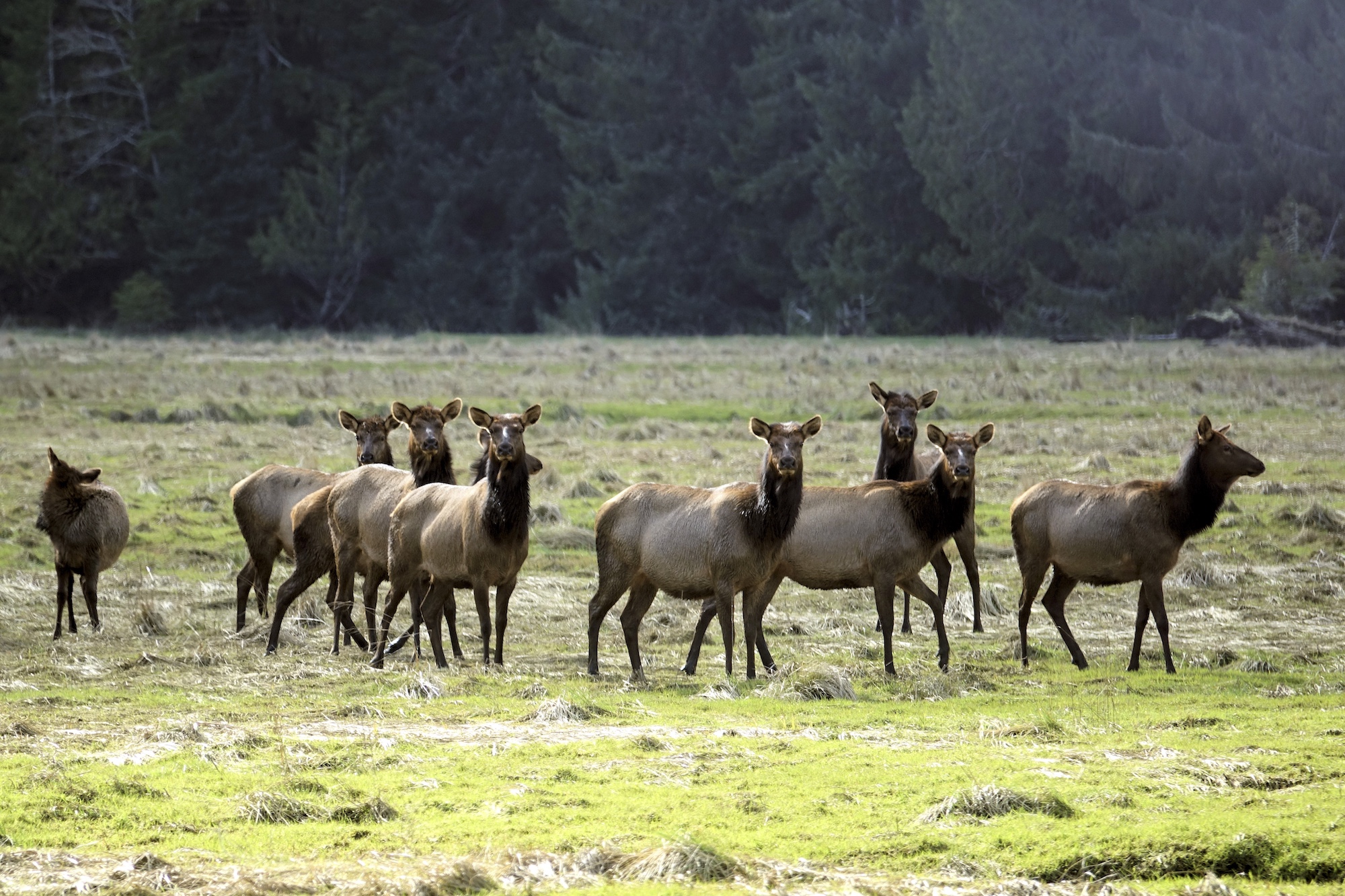
The old growth was already flagged for logging. The main things that saved it were the 1992 listing of the marbled murrelet, the little seabird that feeds over the ocean but nests in old-growth trees, and the 1996 designation of critical murrelet habitat, which included these old trees. (The more highly-publicized 1990 listing of the northern spotted owl has had less impact. No one has seen a spotted owl at Ellsworth Creek since 1999.) The forest harbors nesting murrelets every year. "We don't have a good count of the murrelets," Ferrier explains. "They're not an easy species to count." Re-creating habitat for them is "a long, long-term project," Ferrier says. But over the long term with luck, the reforested areas will eventually harbor a lot more.
With luck and with money: Thinning young forests and replacing roads cost way more than the TNC foresters had envisioned. To minimize the impact on standing trees, they started by hauling logs out with helicopters. That’s as expensive as it gets. Meanwhile, the Great Recession was getting under way. TNC started by subsidizing the project, then figured it couldn’t afford to do that anymore. Ellsworth Creek had to sink or swim on its own.
The Conservancy sells wood from the forests it thins to pay for that work and road projects. It also gets money from grants. The state's new capital budget includes $1 million for similar work TNC is doing along the Hoh River, where it owns 10,000 acres — last year, it received 7,000 acres from the Hoh River Trust — and along the Clearwater, a tributary of the Queets, where it owns several thousand acres.
Without the sometimes alarming experience of making the Ellsworth Creek restoration self-sustaining, Rolph says, TNC could never have taken on large-scale restoration along the Hoh and Clearwater.
At least they can sell the wood, something that would be almost impossible in Eastern Washington, where, notes David L. Peterson of the University of Washington's School of Environmental and Forest Sciences, there are few remaining timber mills and the timber isn't worth hauling long distances.
Here, the scrawny trees being lifted from steep slopes on overhead cables run from an old scuffed yarder in the Ellsworth Creek drainage are sound enough to be sawn into dimensional lumber and close enough to mills at Raymond and Astoria to be hauled at a profit. As long as logging contractors can get out at least four log truck loads every day they cut, they can do it at a profit, too — which, understandably, is the only way they’ll do it at all.
The loggers come from southwest Washington, where jobs in the woods and mills have grown scarce. People can look back at the good old days before the spotted owl fights of the early 1990s or the industry restructuring of the early 1980s, but in the big picture, forest products employment on the coast hit its high-water mark before the Great Depression.
"What [the forest products industry is] being replaced with [doesn't provide] nearly the wages we had," says Jim Vleming, regional economist for the state Department of Employment Security. In terms of employment, "we haven't really gotten back to even pre-recession" levels, he says. "The recovery's kind of stuck to the major urban areas."
Historical numbers don't tell the whole story, though. Timber prices are up right now. Corporate forest owners want returns on their investments, and as a result, "logging is as good as it's been in the last 20 years," Ohrberg says. Still, that activity doesn't translate inevitably into local employment. "I see a lot of people from out of town" working in the area, he says.
TNC’s Rolph says the restoration effort "actually provides a lot of jobs; probably more than commercial timber management [would]." It's very labor-intensive. "We've got to run multiple cable lines and move them more often and have people all down through the woods. It takes larger crews."
Loggers aren't the only locals welcome at Ellsworth Creek. TNC also lets people fish, hunt and gather mushrooms on the land; they just can't drive past the gates. Rolph has no problem, for instance, when he sees a bow-hunter's RV parked right outside a gate.
People in nearby communities "see that we're actively managing the land," Rolph says, and not bearing out the stereotypical reactions: "They're gonna lock it up" or "You're just going to buy it and sell it to the national park."
There's no question of locking up or selling off the state forests on which a joint UW-Department of Natural Resources (DNR) experiment will explore ways of hastening the growth of forests farther up the coast, explains Bernard Bormann, director of UW’s Olympic Natural Resources Center in Forks and a UW professor of forest ecology. Bormann points out that on state forest land, the DNR must fulfill legal obligations to both raise money for public schools and other constitutionally-designated beneficiaries and protect forests under a federally-approved habitat conservation plan.
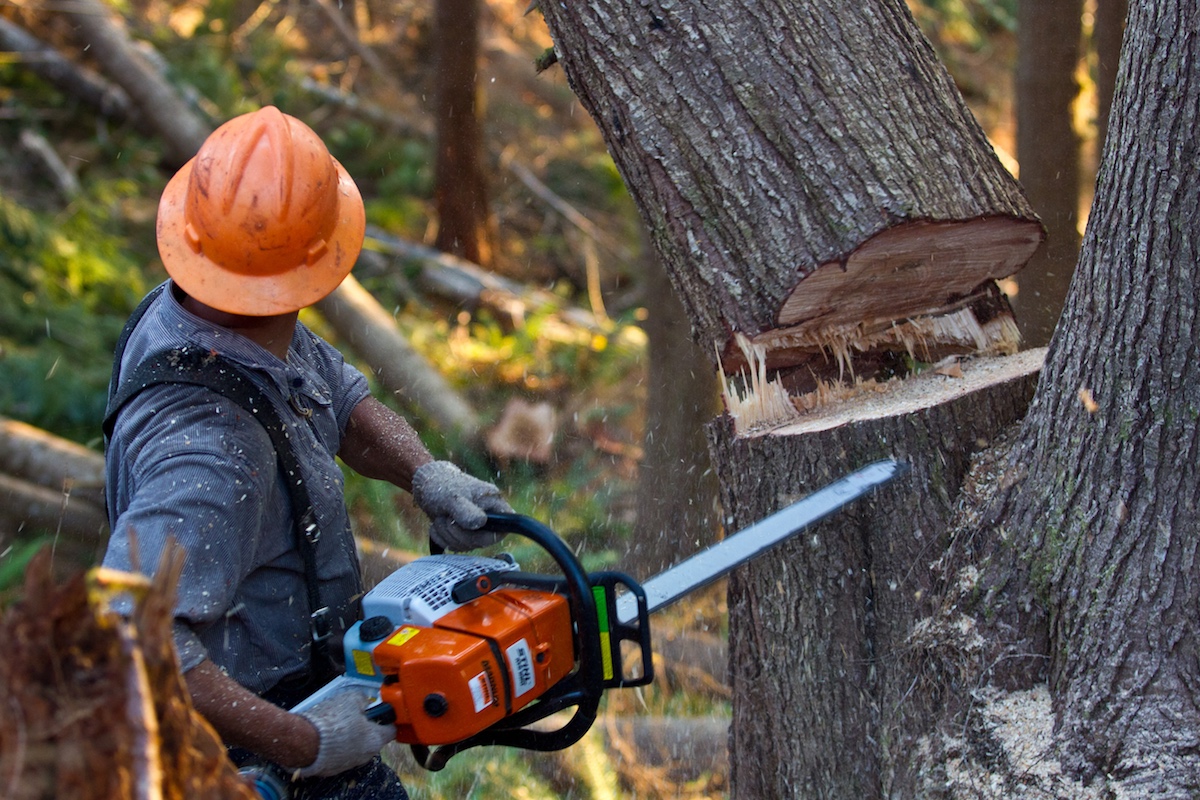
He and his colleagues want to figure out not only how they can speed the development of trees but also, as TNC is trying to do, how they can restore a more natural mix of tree species.
His group will experiment with different methods and scales of removing young trees from densely-forested sites. The study will cover 16 watersheds, most near the TNC land along the Hoh and Clearwater rivers, some east of Kalaloch. Researchers will start collecting baseline data this summer.
As on The Nature Conservancy’s land, getting trees to grow better also won't be the sole measure of success. Communities — both people who live nearby and statewide communities of interest — should gain something from the process, too. To gauge community benefit, "we'll do the standard measurements of jobs and taxes," Bormann says, but "we just think that's not a very good metric." He prefers a broader measure of "community well-being." What that means isn't obvious.
Bormann's group is talking to a variety of people on the coast and elsewhere to come up with a definition. Tribal members have led them to see the forest as more than just trees. "Many, many plant species … were really central to the tribal culture," Bormann says. He sees "opportunities to build them into these forest management prescriptions." He and his colleagues are "exploring with the tribes which species are important. One that stood out right away is beargrass." On the Olympic Peninsula, he says, it grows at lower elevations, "which it doesn't do anywhere else." (If you hike up Mount Si, you won't find it until you've walked about three miles.) By now, there's very little beargrass left along the coast, and Bormann says it's hard to establish, but theoretically, the UW and state researchers "could go in after a harvest and see if we could establish really a lot of beargrass." He says the tribes have been talking about starting a nursery on the Quilleute reservation that could propagate it and other culturally important species.
Like the Conservancy foresters, Bormann and his colleagues will try to encourage the growth of Western red cedar. That's easier said than done, Bormann says. He explains that deer and elk tend to munch off the growing tips. He notes that TNC has planted red cedar next to spikier, harder-to-munch Sitka spruce. Indeed, on an old logging road bed that has been excavated and deliberately replanted, TNC’s Smith points to pairs of twinned seedlings, the flat, dull-green foliage of young cedar growing right against the brighter, more forbidding needles of young spruce.
Smith leads the way along the old right-of-way down a steep slope to Ellsworth Creek. At the bottom of the hill, the creek is jammed with logs, including two huge sections of old-growth cedar that had once been part of the road. Log jams are good for salmon. Once upon a time, government agencies paid people to pull large woody debris out of streams. Now, they pay people to put it back. TNC has already paid people to put a lot back into the Hoh.
Smith and Rolph both talk about hearing chum salmon thrash through the shallows when fish run up Ellsworth Creek. Another TNC forester, David Ryan, has written, “When the rains start to come down in October, my forays to the creek increase. … Within a couple hundred yards of the creek, my steps slow and my ears open as I listen for the splashing and thrashing of salmon on the move upstream.”
The foresters' long-term vision: Re-create — or establish conditions that will let nature re-create — the old coastal landscape of extravagant plenty, the huge old trees under which native communities and early European-American settlers walked, the great salmon runs that left dead fish along the banks of every river and stream — where they fed eagles, bears, even deer, as well as the trees themselves. Salmon were central to the whole ecosystem.
The real goal, Rolph says, is “to make salmon abundant again.”
